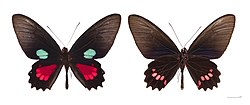Parides aeneas
| Parides aeneas | |
|---|---|

| |
| Female, upperside (left) and underside (right) | |
| Scientific classification | |
| Kingdom: | Animalia |
| Phylum: | Arthropoda |
| Class: | Insecta |
| Order: | |
| Family: | Papilionidae |
| Genus: | |
| Species: | P. aeneas
|
| Binomial name | |
| Parides aeneas | |
| Synonyms | |
| |
Parides aeneas is a species of
The larva feeds on Aristolochia burchelli and A. barbata
Subspecies
- P. a. aeneas Guianas, Surinam
- P. a. bolivar (Hewitson, 1850) Ecuador, NE.Peru, Colombia, Brazil (Amazonas)
- P. a. opalinus Butler, 1877 Brazil (Amazonas)
- P. a. damis (Rothschild & Jordan, 1906) Peru
- P. a. locris (Rothschild & Jordan, 1906) Bolivia
- P. a. gabrielensis (Bryk, 1953) Brazil (Amazonas)
- P. a. marcius (Hübner, [1816]) Brazil (Pará)
- P. a. huallaga Racheli, 1988 Peru
- P. a. lamasi Racheli, 1988 Peru
- P. a. tucha Racheli, 1988 Peru
- P. a. linoides Brown & Lamas, 1994 Brazil (Pará)
- P. a. lucasi Brown & Lamas, 1994 French Guiana
- P. a. didas Brown & Lamas, 1994 Guiana, Surinam, French Guiana
Description from Seitz
P. aeneas. Palpi black, as in the preceding species. Abdomen in the female with a small red spot beneath before the tip. Sexes very different. Male with green spot on the forewing; hindwing with red nonopalescent central area, not extending further towards the base than to the middle of the cell. In the female the forewing is either entirely black, or bears one or more white obsolete spots on the margins. Guiana; Upper Orinoco; Amazon from Para upwards; eastern slopes of the Andes of Peru and Bolivia. Several geographical forms. A woodland species, about whose earlier stages nothing is known. — aeneas L. (= gargasus Hbn. ; aeneides Esp). ; bochus Luc.) (2 b) inhabits the three Guianas. The green spot of the male is removed from the cell, and is usually wider before than behind the submedian vein. The female occurs in two forms: female-f. specularis R. & J. has on the forewing a large white spot before the 1. median, and usually several smaller ones, of which one is in the cell. In the second form, female -f. dido R. & J., the forewing has no white spots. — marcius Hbn. (2 b) is the subspecies from the Lower Amazon. The male is similar to that of aeneas, but the last red spot but one on the under surface is larger. We know only one form of the female; in this the white spot of the forewing — linus R. & J. from the Middle Amazon (Santarem, Obidos, Massauary) was unknown to Bates. The red spots on the underside of the hindwing of the male are paler than in the last subspecies, and stand closer together and nearer to the cell. In the female the red spots are united into an uninterrupted band. — damis R. & J. inhabits East Peru. The green spot of the male is larger than in the preceding forms, and the spots on the under surface of the hindwing are reddish white. The female occurs in two forms: female-f pyromelas R. & J. (2b) has entirely black forewing; the red spots of the hindwing are confluent, forming a band. In female -f. eucharia R. & J. the forewing has a large white area with undefined margins. — locris R. & J. is in the male similar to the last subspecies, but the red spots on the hindwing are larger. The female has always a white area on the fore-wing; the red spots on the hindwing are separated from one another, the spot before the 1. median being the largest. Bolivia. — bolivar Hew. (2 a) inhabits the Upper Amazon and the Orinoco. The red area on the hindwing of the male is small, and is whitish yellow on the under surface. Forewing of the female black , with white spots on the fringes ; hindwing with a whitish yellow area.[2]
-
Seitz Plate 2
-
Original description
-
Gray Catalogue 1853
-
Uitlandsche Kapellen
Status
Parides aeneas is common and not known to be threatened.[3]
Taxonomy
Parides aeneas is a member of the aeneas species group[4]
The members are
- Parides aeneas
- Parides aglaope
- Parides burchellanus
- Parides echemon
- Parides eurimedes
- Parides lysander
- Parides neophilus
- Parides orellana
- Parides panthonus
- Parides tros
- Parides zacynthus
References
- ^ Linnaeus, C. (1758) Systema naturae per regna tria naturae, secundum Classes, Ordines, Genera, Species, cum Characteribus, Differentiis, Synonymis, Locis. Vol. 1 (Animalia)., Linnaeus, C. (1758) Systema naturae per regna tria naturae, secundum Classes, Ordines, Genera, Species, cum Characteribus, Differentiis, Synonymis, Locis. Vol. 1 (Animalia). , Laurentii Salvii, Holmiae [Stockholm].
- ^
Jordan, K. , in Seitz, A. ( 1907) . The Macrolepidoptera of the World. 5: The Macrolepidoptera of the American faunistic region. Papilionidae 1-45.
 This article incorporates text from this source, which is in the public domain.
This article incorporates text from this source, which is in the public domain.
- ISBN 978-2-88032-603-6– via Biodiversity Heritage Library.
- ISBN 9783937783277
- Lewis, H. L., 1974 Butterflies of the World ISBN 0-245-52097-XPage 25, figure 18
- Edwin Möhn, 2006 Schmetterlinge der Erde, Butterflies of the world Part XXVI (26), Papilionidae XIII. Parides. Edited by Erich Bauer and Thomas Frankenbach Keltern: Goecke & Evers; Canterbury: Hillside Books. ISBN 978-3-937783-27-7(Supplement 13 in English - by Racheli)
- Racheli, T. (1988) Taxonomic and nomenclatorial notes on Parides aeneas (Linnaeus, 1758) with description of three new subspecies from Peru (Lepidoptera, Papilionidae). Fragmenta Entomologica 20 (2): 143-154 (7 figs.).




